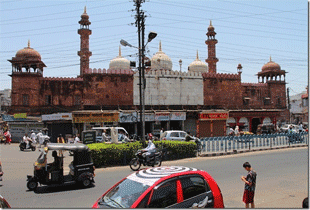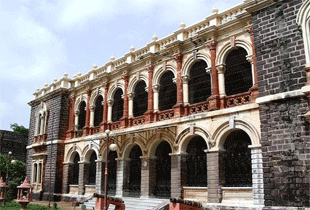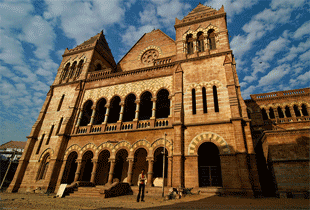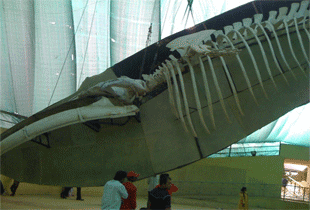Bhuj, India
Bhuj is a popular tourist destination, which is situated in the Kutch district of Gujarat. It is the administrative city of Kutch. Therefore, it occupies an important place on the map of India. The distance between Ahmedabad and Bhuj by road is around 396 km. It is an interesting place because of the fact that it used to be the capital city of the Princely state of Kutch. This is the reason; Bhuj is one of the most admired places in India, from tourism point of view. The place is studded with a number of rich princely buildings of the yore that are truly a feast for the eyes.
This is a historic city positioned between Bhujiyo Dungar Hill and Hamirsar Lake. Bhuj has got its name from the hill Bhujiyo Dungar only. The Rajput rulers in Kutch were said to have arrived in Bhuj from Sind or Northern India. The history of Bhuj dates back to the period of Naga Chieftain. The city has also witnessed the beautiful era of the Indus Valley Civilization. It also accounts the exile period of Pandavas along with the attack of Alexander the Great.
The city was established by Rao Khengarji I. Due to the strategic location of the place, he chose it for setting up the city. Situated at the base of the hill Bhujiyo Dungar, the location was ideal and he established the city as Bhuj in 1548 AD. It served as the capital city of the princely state till 1947 AD. Bhuj rulers received great support from Mughal rulers. After the declination of the Mughals, the rulers created a huge fort in the city to serve the need of security. In 1819, the British overtook the fort.
Visit in Bhuj
The capital city of Kutch is an interesting city, which reconstructed after the massive earthquake of 2001. There are a number of historical places to visit Bhuj that enhance the beauty of this place. On your visit to Bhuj, you can also come across many tourist attractions. Some of the famous places to visit in Bhuj are:
Aaina Mahal is one of the most delicate places to visit in Bhuj. It is located in the fort complex beside the Parag Mahal. The palace enjoys great work of art and is a must visit attraction for all. Architecture of the palace is beautifully influenced with European architectural style. The palace was constructed by a popular architect named Ramsinh Malam. Coming sheer out of a dream, the palace is truly an architectural marvel. This two storied building features Darbar Hall, hall of mirrors and suites for the royal families. It is decorated beautifully with mirror work, tile work and fountains.
Prag Mahal is another great attraction of Bhuj. The palace was designed by the eminent architect Colonel Henry Saint Wilkins. It took 10 years in the construction of this monument and cost was around Rs. 20 Lakh. The palace serves as a great example of Italian Gothic style and combines some incredible European style elements.
Earlier recognized as Fergusson Museum, Kutch Museum is one of the popular sightseeing places in the city. It was constructed by Maharao Khengarji III in 1877 AD. Situated on the banks of the Hamirsar Lake, the museum is built in Italian style. The museum has a rich selection of Kshatrapa inscriptions offering a number of archeological objects, great collection of arms and specimens and different art & crafts of the Kutch region.
Set amidst the shady trees full of crows and bats, this elegant Italianate palace was built in year 1867. The place was owned by Maharao and after his death; it is turned into a small museum. The palace features well-manicured gardens, which are beautiful and spacious. In this museum, personal possessions of Maharao can be seen.
This is the complex that houses three eminent palaces of Bhuj. It is in a gloomy state and most of its sections are closed. The palatial complex is worth visiting for its indistinct Durbar Hall, which is a magnificent piece of rotten chandeliers, hunting trophies and gold-skirted classical statues.
This is not just a park but a complete activity center for the travelers especially who love art & crafts. There are lots of shopping options available here for dress materials, including traditional Gujarati work. Buy here thread work, footwear, crafts, tie & dye fabrics, carpets and shawls.
It is one of the best places to seen in Bhuj that still remained in proper condition after witnessing the earthquake. This is a peaceful and lovely place that is ideal for history lovers. You can enjoy here a good photography session.
It is one of the biggest gardens of Bhuj located over a hill. This garden enjoys the panoramic view of the entire Bhuj city. A number of couples and families with kids can be seen here roaming around.
Shree Swaminarayan Temple is an amazingly built temple in the city, which is full of beautiful marble carvings. The place is calm and attractive and features intricate designs appealing to the visitors. Along with being a religious attraction, it is an architectural marvel too.
This is a single hall museum located 56 KM away from Bhuj. You can see here million years old wood fossils at an island that is absolutely deserted. The location of the park is not much good as you have to go off the road to reach there. The place is very peaceful and collection of the fossils is awesome. However, there is lack of information and promotion.
Bhuj, India

March to Mid-June, Warm yet Pleasant
Temperature:28°C – 35°C

July to October, receives heavy rainfall
Annual rainfall -1300mm

Last November to February, Cool and Charming
Temperature:8°C – 22°C
Sights of Bhuj



